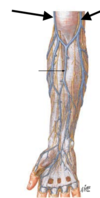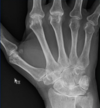Upper Body Flashcards
(171 cards)






Pronator Teres
Orgin
Insertion
Innervation
action
Medial Epicondyle - Humerus and Ulnar Head
Middle lateral surface of radius
Median n.
Pronates forearm and hand; flexes forearm
Flexor carpi radialis
orgin
insertion
innervation
Medial epicondyle - humerus
Base of 2nd metacarpal
Median n
Flexes and abducts hand
Palmaris longus
orgin
insertion
innervation
action
Medial epicondyle - humerus
Flexor retinaculum and palmar aponeurosis
Median n.
Flexes hand and tenses palmar aponeurosis
Flexor carpi ulnaris
orgin
insertion
innervation
action
Humeral head - Medial epicondyle and Ulnar head - Olecrannon process (medial edge)
Pisiform, hook of hamate and 5th metacarpal
Ulnar n.
Flexes and adducts hand
Flexor digitorum superficialis
orgin
insertion
innervation
action
Humeroulnar head and Radial head
Middle phalanges of 4 fingers
Median n.
Flexes PIP, MCP of 4 fingers and wrists
Flexor digitorum profundus
orgin
insertion
innervation
action
Anterior ulna and interosseous membrane
Distal phalanges of 4 fingers
Anterior interosseous br. of median for radial half
ulnar n. for ulnar half
Flexes DIP, MCP, PIP of 4 fingers; flexes wrists
Flexor pollicis longus
orgin
insertion
innervation
action
Anterior radius and interosseous membrane
Distal phalanx of thumb
Anterior interosseous br. of median n.
Flexes thumb MCP and carpometacarpal joints
Brachioradialis
orgin
insertion
innervation
action
Lateral supracondylar ridge of humerus
lateral surface of distal radius
Radial n.
flexes forearm
Extensor carpi radialis longus
orgin
insertion
innervation
action
Lateral supracondylar ridge of humerus
Base of 2nd metacarpal
Radial n.
Extends and abducts hand
Extensor carpi radialis brevis
orgin
insertion
innervation
action
Lateral epicondyle
Base of 3rd metacarpal
Deep radial n./Post. interosseous n.
Extends and abducts hand
Extensor digitorum
orgin
insertion
innervation
action
Lateral epicondyle
Dorsal surface of the distal and middle phalanges of 4 fingers
Deep radial n./Post. interosseous n.
Extends fingers at MCP and interphalangeal joints
Extensor carpi ulnaris
orgin
insertion
innervation
action
Lateral epicondyle and posterior ulna
Base of 5th metacarpal
Deep radial n./Post. interosseous n.
Extends and adducts hand
Supinator
orgin
insertion
innervation
action
Lateral epidondyle, radial collateral and annular ligaments, post. ulna
Lateral, anterior/posterior radius
Deep radial n./Post. interosseous n.
Supinates forearm
Abductor pollicis longus
orgin
insertion
innervation
action
Posterior ulna, interosseous membrane and post. radius
Base of 1st metacarpal
Deep radial n./Post. interosseous n.
Abducts and extends thumb
Extensor pollicis brevis
orgin
insertion
innervation
action
Posterior radius and interosseous membrane
Base of proximal phalanx of thumb
Deep radial n./Post. interosseous n.
Extends thumb at MCP and CM joints
Extensor pollicis longus
orgin
insertion
innervation
action
Posterior ulna and interosseous membrane
Base of distal phalanx of thumb
Deep radial n./Post. interosseous n.
Extends thumb at IP, MCP and CM joints
boundaries of the ‘anatomical snuff box’ (medial, lateral, floor)
What nerve passes through it?
Extensor pollicis longus (EPL) tendon - medially
Extensor pollicis brevis (EPB) tendon - laterally
Abductor pollicis longus (APL) tendon - laterally
floor - scaphoid (most frequent fractured carpal) and trapezium
radial artery
superficial radial n.

Carpal tunnel
What are its contents?
flexor retinaculum spans the lateral-most and medial-most carpal bones of the proximal and distal rows
- 4 Flexor digitorum superficialis tendons
- 4 Flexor digitorum profundus tendons
- Flexor pollicis longus tendon
- Median nerve

What is high-energy phosphate transfer potential?
name 1 example
Breaking the terminal phosphate bond of ATP releases energy –> drives rxns in the cell
example: phosphocreatine and ATP reaction; phosphocreatine
The creation of ATP without oxygen is called?
substrate-level phosphorylation
High energy compounds found in the Glycolytic pathway that have high-energy phosphate transfer potential? (4)
Phosphoenolpyruvate >> phosphocreatine (creatine phosphate) > 1,3-bisphosphoglycerate >> ATP (gamma-phosphate)
























